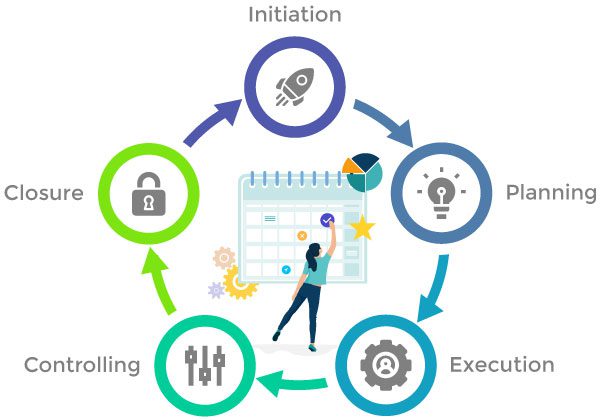A business takes up a ‘project’ to achieve certain goals and fulfill aspirations. This ‘project’ involves multiple stages and often turns out to be daunting if a proper plan is not chalked out in advance.
Commonly known as ‘Project Management’ – a complicated process with its building blocks aiming to achieve the goals. However, as complicated as it may sound, it makes your journey smooth and increases your probability of fulfilling your business goals.
Don’t believe it?
According to research, 90% of the businesses that adopt project management for executing their projects report having experienced efficiency as well as innovation.
Project management involves chalking out a plan right from planning to executing it and then controlling it to get effective results. Not just that, it also comes with planning for proper budget allocation and resource management throughout the process.
But the real question arises now – despite most businesses opting for project management, why aren’t these businesses able to achieve their goals? That is because their project managers lack the knowledge and skills one needs to achieve 100% results.
Project management is not an easy task. It comes with its own skills and techniques to be applied for successful project completion. You may get a feeling that choosing the right project management software will do, but there is no guarantee that you will get consistent results by employing software.
For you to see great results every time, just getting the right project management software will not suffice as you need to learn the skills and techniques for project management to get what you aim for.
In this blog, you’ll learn about the 10 Best Project Management Techniques you need to know for effective project management.
But before that, let us get you to understand what project management is and the different phases that project management involves.
WHAT IS PROJECT MANAGEMENT?
As the term implies, project management is nothing but the application of skills, technique, and knowledge to achieve goals in a specified time. Project management is adopted to ensure a solid foundation for project completion and a smoother and efficient path to achieving the goals. It is not just about the implementation of the project management techniques but also keeping budget allocation and resource management in check.
No one can guarantee you a way to successfully achieve your goals but project management framework and methodologies do surely help you streamline your tasks and fuel your operational engine to get there.
Let’s now get to the different phases that project management involves.
WHAT ARE THE DIFFERENT PHASES OF PROJECT MANAGEMENT?
Project management differs from industry to industry but follows a standard project management framework which can be summed as follows:

Source: PeppyBiz
- The Commencement Phase: This is your first step towards your project and requires you to set your mind on a well-thought business plan. You need to work it out and then get it approved by the stakeholders before you begin with anything. This is the most important stage and requires you to be very careful as you are about to lay the foundation of your project management.
- The Planning Phase: This part can be tedious, but one ought to invest the most energy to sort out your project’s framework. The achievement of the task will depend on how you plan it. Your task plan should answer all the ‘who, when, why, where, how’ for your process. This is the phase wherein you plan on the execution strategy for your project.
- The Execution Phase: This is where all your planning comes into play. Now that you are aware of the 360-degree view of what you want to achieve and how you want to progress with it, this phase is all about executing and taking effective steps for ensuring a smoother process by managing the team, facilitating better communication, and delivering upon value. It is all about how you want to start off with the project.
- The Monitoring Phase: Each and every task you do pays off only when it is measured of its effectiveness – that is where Key Performance Indicators (KPI’s) come into action to better judge the performance of the techniques you may be following. It helps you control your activities and help you get on track. It also helps in meeting the deadlines for your goals.
- The Assessment and the Closing Phase: This stage includes wrapping up the venture and it comprises an evaluation of the venture. It is evaluated on the basis of the KPI indicators and the goals pursued and achieved. Once that is done, you can therefore see how well you undertook the project and judge its competency and make room for improvements in the future.
Now that you are familiar with the standard framework for project management, it is time for you to discover the 10 Best project management methodologies you must know for your business.
10 BEST PROJECT MANAGEMENT TECHNIQUES YOU MUST KNOW ABOUT
1. The Traditional Yet Classic Technique
This is a technique mostly undertaken by smaller teams looking for carrying out short-term projects. It is the most widely used technique and helps in completing projects quicker and with ease. It includes planning and laying out tasks and then allocating them to different teams or individuals, basic allocation of resources, and looking after budgeting for the process. It is then followed by an assessment with getting feedback and taking reviews after the project is finished.
2. The Waterfall Technique
As the name suggests, this technique carries out the project like a waterfall i.e in a sequential manner. This means that you move to the next part of the sequence only if you finish the task allotted to you and you fulfill it with utmost satisfaction. Gantt charts are also used in this technique to evaluate and monitor progress. The different phases involved in this technique are as follows:
- Framework
- Prerequisites for Planning
- Laying out the plan and Execution
- Improvements in the Process
- Coordination and Testing
- User Acceptance (UAT) consists of a process of verifying that a solution works for the user
3. Agile Project Management Technique
The major aim of this technique is to produce value for your clients. In this technique the project is completed in stages majorly – starting from planning, then going to execution, and ending at making room for improvements.
Such projects often call for self-organization and collaboration for maximum results. Since this is a value-centric approach, there are repetitive corrections at all stages until the project delivered is of 100% quality. This approach is commonly used for IT Projects which could not be worked upon using traditional project management techniques.
4. Program Evaluation and Review Technique (PERT)
Does your team deliver upon deadlines?
Oftentimes, teams are not able to complete projects on time and that’s where PERT comes in. This technique helps you prepare for delivering complex projects in time by making the right time estimates.
This technique was in fact created by the US Navy for its project management requirement as it helps prepare you for solving complex project requirements. In this technique, various charts such as PERT charts and Gant charts are used for making better assessments. This technique is a go-to technique for projects that are long-term and require you to get into the details to be able to complete the project.
5. Critical Path Method (CPM)
This method is used in integration with the PERT.
CPM necessitates that you build a model that lists down all the tasks needed to complete the project or a WBS considering everything surrounding it such as the length to finish off each one of those tasks, the dependencies – achievements and expectations, for the task.
Based on this model, the algorithms are used and you can even find out the longest path of the project. Once you do this, you can figure out the critical tasks which need more time and control. All in all, you can find out the shortest duration in which the project can be completed with maximum efficiency.
6. The Kanban Approach

Source: PeppyBiz
This method was developed by the Japanese to increase efficiencies in manufacturing. It is used in lean and Just in time (JIT) manufacturing. The Kanban technique is a way to visualize the task of your project.
This approach gives you a visual representation of the workflow which in turn helps your team to understand their roles in a wider context, cuts down on the work in progress, and avoids unnecessary pressure on any one individual. It helps the team to better prioritize tasks and improve workflow and efficiency.
This technique helps you in reducing waste and maximizing the output in a collaborative environment.
7. Critical Chain Technique
The Critical Chain technique is just a modified version of the Critical Path technique. Unlike the Critical Path Technique where the focus is on scheduling, the Critical Chain technique’s focus is on using limited resources and time efficiently. It focuses on managing the resources better to execute the tasks.
This strategy is used in projects that require maximum usage of limited resources.
8. Rational Unified Process (RUP)
This model focuses on the user’s satisfaction. It focuses on providing value to the end-user and works on a regular feedback system. It works like an iterative process where after each task is completed, reviews and feedback are taken to make improvements.
This model is adopted for software development projects. It helps you envision certain goals and then chalk out a plan to deliver upon those.
9. PRINCE2
This is a well-known technique used in more than 150 nations.
It uses an approach in which the focus is entirely on the process of the project. Also known as Project in Controlled environments, the approach lays out a thorough project plan in which each stage of the process is well thought of with detailed planning and if the project has any loose ends, they are tied up after completion.
It was a technique that was earlier devised by the government in the 1980s but later adopted by the private sector companies too as it helps in speedy completion of tasks with improved efficiency.
10. Extreme Project Management (XPM)
This model makes room for flexibility.
Unlike other techniques that focus on detailed planning of the process with little or no room for making changes, this technique focuses on making room for adapting to changes as and when needed during the process.
When you adopt this technique, it will allow you to alter your whole project plan, make changes to your budget allocations and resource planning to fit changing needs. It is suitable for short-term projects.
CONCLUSION
Undertaking a project today is not an easy task at all. With the rising competition, a project is no more just a way to complete a milestone but a stepping stone to progress your business.
The project management techniques may vary but they are bound to give you the results you aim to achieve.
So, without wasting any time, adopt some of the techniques mentioned above as per your needs in your projects and see for yourself how these techniques can change your game in building your business empire!



